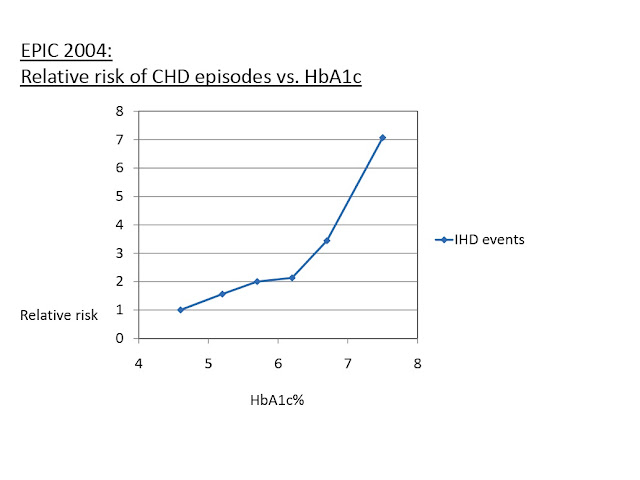This post follows a discussion on the
results of my recent blood test where my HbA1c was measured at 6.1%. My exercise regimen and body shape was described
previously. (At present, mainstream medical practice uses
Fasting Blood Glucose (FBG) and the
Oral Glucose Tolerance Test (OGTT) to screen for diabetes. The HbA1c test is typically only prescribed for diabetic patients to measure long term blood glucose control. Unless you are a diabetic, your doctor may not order an HbA1c for you. You may have to specifically request one.)
Asking The Right Questions?
I wondered why my HbA1c would be high while my fasting blood glucose and lipid profile appeared within normal range. Average adults have a resting heart rate between 60 to 80 beats per minute. My resting heart rate of
49 bpm at age 44 generally indicates a high stroke-volume efficiency. My blood pressure of 110/75 did not raise red flags. This got me thinking about the metabolic adaptation of athletes.
What About Athletes?
Most HbA1c reference data is derived from diabetic patients. Risk associations with HbA1c levels are thus based on reference data with underlying pathologies that are abnormal. Were there any studies that looked at the HbA1c of athletes? That question led me to a study called
Glycaemic Control in Athletes by a group of Italian researchers named Lippi, Montagnana, Salvagno, Franchini and Guidi from the University of Verona in Italy which was first published in 2007 and again in January 2008 in the International Journal of Sports Medicine.
What they found was statistically significant differences in fasting blood glucose and HbA1c between the sedentary group, elite cycling athletes and professional cyclists. Would you like to guess which way the HbA1c of elite athletes differed from the sedentary group? It trended
higher at 5.4% than the sedentary group at 5.2% The study did not answer
why the cycling athletes had higher HbA1c readings. They did hint that sedentary reference data should not be used to evaluate athletes.
Did the cyclists in Lippi's study have higher HbA1c readings due to some metabolic adaptation where the body makes more glucose available for longer periods to meet the energy demands of their activity or were the readings caused by the cyclists eating larger carbohydrate meals to balance their energy requirements resulting in higher post-prandial blood sugar over time?
[January 14, 2011 update: I have since found this study which shows blood glucose can rise as high as 6.6 to 8.9 mmol/L during recovery from short term, high intensity exercise. As Fast-Twitch muscle fibers are depleted of glycogen during short term, high intensity exercise, the body rapidly resynthesizes glycogen to replenish muscles by raising glucose and insulin levels. How hard you exerted yourself during the exercise affects how high your blood sugar levels rise immediately after.]
Athletes Are Different
Prior to this in 2004, Lippi was involved in another study
measuring serum creatinine, uric acid, albumin and glucose in professional athletes. The summary was that laboratory testing results based on sedentary population reference points were not useful for athletes. This confirms
another study which researched the glomerular filtration rate (GFR) - a measure of kidney function - in endurance athletes versus a sedentary control group. Basically, if you exercise hard and are extremely fit for your age group as measured by weight, performance, strength and cardiovascular endurance, the standard laboratory flags of blood test readings may not be applicable. The laboratory's range of acceptable readings do not take into account metabolic adaptations by the intensity and workload of your exercise regimen.
Do Genetics Play A Role?
In another study published in May 2005 out of China,
the glycemic control between power athletes and endurance athletes was compared. They took juvenile track athletes between 12 and 13 years old and classified them between short-distance runners (power athletes) and long-distance runners (endurance athletes). They performed an
Oral Glucose Tolerance Test on both groups. In the second part of the study, they took adult athlete swimmers and divided them between short-distance (power) and long-distance (endurance) groups. Once again the OGTT was given to both groups.
With both juvenile track and adult swimming athletes, insulin sensitivity was significantly
lower with the power athletes. Low Density Lipoprotein cholesterol, total cholesterol and triglycerides were also significantly
higher with the power athletes.
Their conclusion was that the
genetic makeup of an athlete reflects their metabolic composition. Those who were more insulin resistant favored power sports, while those more sensitive to insulin favored endurance sports. This confirms the anecdotal saying that
the athlete does not select the sport, rather it is the sport which selects the athlete. The athlete with higher average blood glucose in their blood selects a sport which rewards sudden and short bursts of energy. Whereas the athlete with lower average blood sugar in their system excels in sports where energy outputs have to be sustained for longer periods of time.
Conclusion
I think one reason athletes have higher HbA1c readings is due to the liver releasing its stores of glycogen during vigorous exercise thereby raising blood sugar to meet energy requirements. When the exercise is intense enough to produce lactic acid in the muscles, the body converts the lactate buildup into glucose via
gluconeogenesis which also raises blood sugar especially when the athlete has not eaten prior to the workout. This is known as working out in a fasted state or a fasted workout.
Once the energy demand subsides, the body releases insulin to store the excess sugar which lowers blood sugar once more. This cycle increases the body's sensitivity to insulin; making a person much less likely to become insulin resistant.
Victor












































